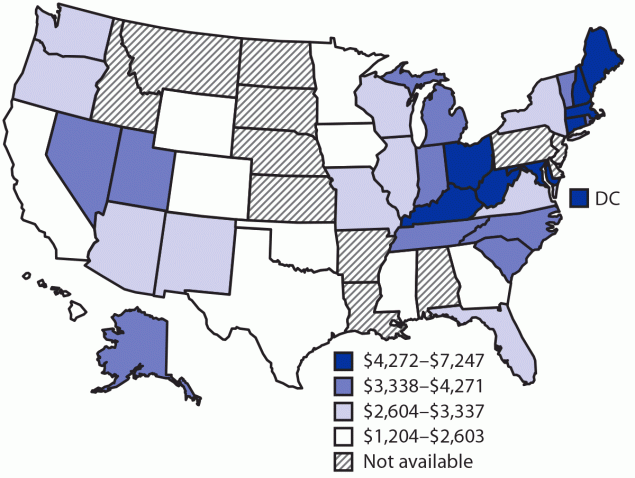Study: Kentucky ranks fourth, among 38 states studied, in per-resident costs of opioid-use disorder and deaths resulting from it

By Melissa Patrick
Kentucky Health News
Kentucky ranked fourth in cost of opioid-use disorder and deaths from it, adjusted for population, in a report that shows the economic impact of the opioid epidemic across most of the nation.
The Centers for Disease Control and Prevention report found Kentucky’s combined per-resident costs from opioid-use disorder and its resulting deaths in 2017 was $5,491, including $3,007 for OUD deaths.
The study covered the 38 states that had sufficiently specific data. Only West Virginia, Ohio and New Hampshire spent more per person because of OUD and its deaths than Kentucky. Kentucky ranked second for per-resident cost of OUD, after Nevada, and 10th for per-resident spending on OUD deaths.
Nationwide, the combined economic cost of opioid-use disorder and OUD deaths in 2017 was about $1 billion, trillion, including $471 billion for OUD and $550 billion for its deaths. The combined cost varied substantially, ranging from $985 million in Wyoming to $72 billion in Ohio.
In Kentucky, that cost was about $24.5 billion, including about $11 billion for opioid-use disorder and $13.4 million for OUD deaths. Kentucky ranked 13th in costs without regard to population.
Costs of opioid-use disorder and fatal overdoses include the costs of health care, substance-use treatment, criminal justice, lost productivity, reduced quality of life, and the value of statistical life lost.
“Reduced quality of life was the largest component of the cost of opioid-use disorder, and the value of statistical life lost was the largest component of the cost of fatal opioid overdose,” says the report. “These two components together accounted for approximately 84% of combined costs, followed by lost productivity.”
The report estimated that Kentucky had 50,000 people with an opioid-use disorder and 1,160 opioid related deaths in 2017.
Opioid epidemic worsens during pandemic
And while the study looked at 2017, likely the most recent year with enough data, it’s important to note that the opioid epidemic hasn’t gone away and has gotten worse since the beginning of the pandemic, suggesting the cost associated with OUD and its deaths has likely gone up since then.
A study published in the journal Drug and Alcohol Dependence found that the daily number of Kentucky ambulance runs for opioid overdose, in the 52 days before and after a state of emergency was declared March 6, rose 17 percent for runs to an emergency department, 71% for runs “with refused transportation, and a 50% increase in runs for suspected opioid overdoses with deaths at the scene.”
These programs are designed to prevent outbreaks of HIV and hepatitis C, which are commonly spread by needle sharing among IV drug users. They also provide health screenings and vaccines, and connect drug users to treatment. They are allowed by a 2015 state law that requires approval by the county health board, the fiscal court and the city where the exchange is to be located.